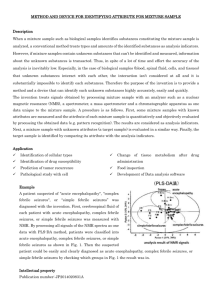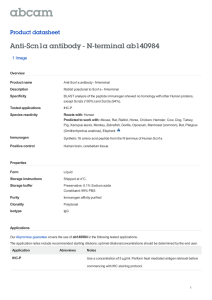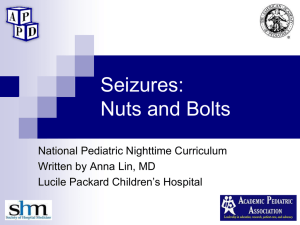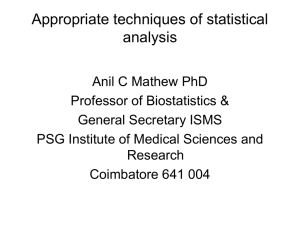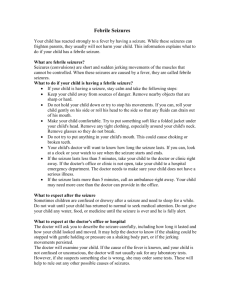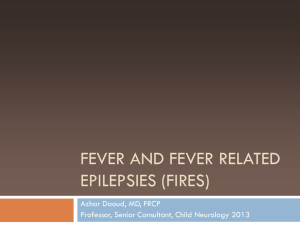Febrile Seizures Show Notes (Word Format)
advertisement
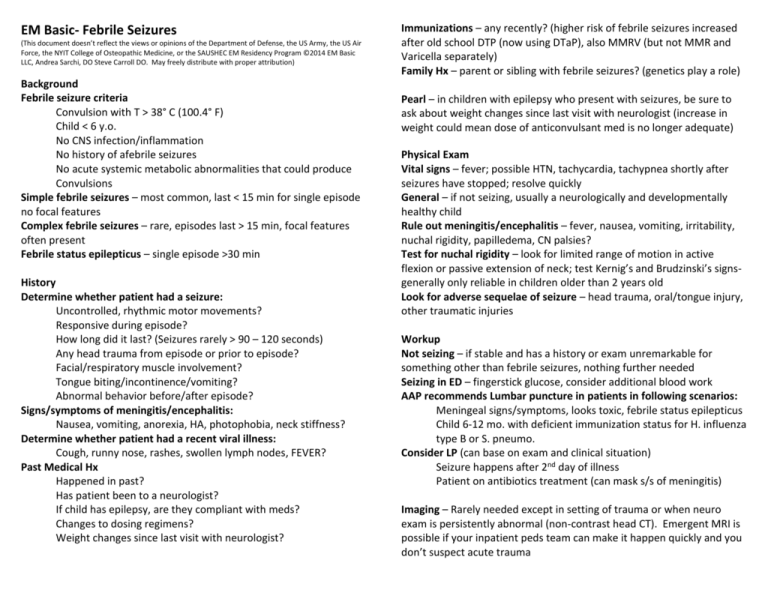
EM Basic- Febrile Seizures (This document doesn’t reflect the views or opinions of the Department of Defense, the US Army, the US Air Force, the NYIT College of Osteopathic Medicine, or the SAUSHEC EM Residency Program ©2014 EM Basic LLC, Andrea Sarchi, DO Steve Carroll DO. May freely distribute with proper attribution) Background Febrile seizure criteria Convulsion with T > 38° C (100.4° F) Child < 6 y.o. No CNS infection/inflammation No history of afebrile seizures No acute systemic metabolic abnormalities that could produce Convulsions Simple febrile seizures – most common, last < 15 min for single episode no focal features Complex febrile seizures – rare, episodes last > 15 min, focal features often present Febrile status epilepticus – single episode >30 min History Determine whether patient had a seizure: Uncontrolled, rhythmic motor movements? Responsive during episode? How long did it last? (Seizures rarely > 90 – 120 seconds) Any head trauma from episode or prior to episode? Facial/respiratory muscle involvement? Tongue biting/incontinence/vomiting? Abnormal behavior before/after episode? Signs/symptoms of meningitis/encephalitis: Nausea, vomiting, anorexia, HA, photophobia, neck stiffness? Determine whether patient had a recent viral illness: Cough, runny nose, rashes, swollen lymph nodes, FEVER? Past Medical Hx Happened in past? Has patient been to a neurologist? If child has epilepsy, are they compliant with meds? Changes to dosing regimens? Weight changes since last visit with neurologist? Immunizations – any recently? (higher risk of febrile seizures increased after old school DTP (now using DTaP), also MMRV (but not MMR and Varicella separately) Family Hx – parent or sibling with febrile seizures? (genetics play a role) Pearl – in children with epilepsy who present with seizures, be sure to ask about weight changes since last visit with neurologist (increase in weight could mean dose of anticonvulsant med is no longer adequate) Physical Exam Vital signs – fever; possible HTN, tachycardia, tachypnea shortly after seizures have stopped; resolve quickly General – if not seizing, usually a neurologically and developmentally healthy child Rule out meningitis/encephalitis – fever, nausea, vomiting, irritability, nuchal rigidity, papilledema, CN palsies? Test for nuchal rigidity – look for limited range of motion in active flexion or passive extension of neck; test Kernig’s and Brudzinski’s signsgenerally only reliable in children older than 2 years old Look for adverse sequelae of seizure – head trauma, oral/tongue injury, other traumatic injuries Workup Not seizing – if stable and has a history or exam unremarkable for something other than febrile seizures, nothing further needed Seizing in ED – fingerstick glucose, consider additional blood work AAP recommends Lumbar puncture in patients in following scenarios: Meningeal signs/symptoms, looks toxic, febrile status epilepticus Child 6-12 mo. with deficient immunization status for H. influenza type B or S. pneumo. Consider LP (can base on exam and clinical situation) Seizure happens after 2nd day of illness Patient on antibiotics treatment (can mask s/s of meningitis) Imaging – Rarely needed except in setting of trauma or when neuro exam is persistently abnormal (non-contrast head CT). Emergent MRI is possible if your inpatient peds team can make it happen quickly and you don’t suspect acute trauma PEARL – standard tests such as CBC, BMP, and calcium level are low yield in patients with likely febrile seizures Which patients to do workup <28 days with fever- Full-court press- labs, cath urine, CXR, LP, antibiotics and admit 29-60 days- Some say LP all, some use Rochester/Philadelphia criteria to determine need for LP- use institutional guidelines 60 days and already has 2 month shots- can start using clinical exam to determine if any workup needed 3 months and vaccinated- occult bacterermia risk is low, can use history and exam to guide workup Children at high risk for UTIs- in general, obtain cath urine Circumcised males < 6 months old (lowest risk) Uncircumcised males <12 months old (medium risk) Females <24 months old (highest risk) Differential Diagnosis Meningitis/encephalitis – if suspicious, order CBC + diff, BMP, blood cultures, LP if no contraindications Syncope – H/P + EKG Shaking chills – rarely involve facial or respiratory muscles, not associated with LOC Metabolic disorder – hx of vomiting/diarrhea, altered fluid intake, or electrolyte abnormality such as hyponatremia Management If seizing: ABCs Place patient on side if seizing O2 as necessary IV access – if not established within 5-10 min of seizure activity, start IO line PEARL: Keep in mind that most seizures are self limited and resolve within 2 minutes- don’t have to be super aggressive with IV/IO access if you witness onset of seizure. Can set up equipment and start the process of getting IV access at the 2 minute mark Glucose – If actively seizing- get fingerstick glucose PEARL: All patients with altered mental status are hypoglycemic until proven otherwise, if you can’t get D-stick, give dextrose empirically Glucose concentrations: Infants: D10 at 5 -10 cc/kg Children: D25 at 2-4 cc/kg Adults: D50 at 1-2 cc/kg PEARL: To remember this, Take 50 and 100 and divide by dextrose concentration (50/D10 = 5 cc/kg, 100/D10 = 10 cc/kg) Anticonvulsants – administer if seizure persists > 5 min Lorazepam 0.05-0.1 mg/kg IV or IM to max dose of 4 mgIf continuesgive additional doseSeizure still persistsfosphenytoin 15-20 mg/kg IV to max dose of 1000 mg No IV access.5 mg/kg rectal diazepam gel to max dose of 20 mg Supportive measures – cooling blanket, antipyretics PEARL – Remember that if the patient is not seizing, stable, and has a hx and PE unremarkable for something other than febrile seizures, then no treatment necessary Hyponatremia treatment- rare cause of seizures in kids, usually from overdilution of formula with water Treatment- 3% hypertonic saline- 3 cc/kg IV bolus until seizures stop Disposition Normal neuro exam and no antiepileptic usedd/c home with PCP followup Persistent seizures requiring antiepileptics/hx of seizures admit Febrile Status epilipiticus- admit ICU Parental Education Important to reassure parents that simple febrile seizures are not harmful to children in of themselves and that it is about how quickly the child’s temperature rises. Re-assure parents that their child’s brain is not “boiling inside of their head.” Make sure they know that there is nothing they could have done to prevent the seizure. Febrile seizures do not increase the risk of a future diagnosis of epilepsy unless the child has already diagnosed developmental delays Antipyretics like acetaminophen and ibuprofen DO NOT prevent febrile seizures- even when given prophylactically (very important to tell parents to avoid unnecessary antipyretics and parental worry) Script by: Dr. Andrea Sarchi (Contact: steve@embasic.org)
![Anti-Nav1.7 antibody [S68-6] - C-terminal (Biotin) ab183416](http://s2.studylib.net/store/data/012700010_1-91302de8adf12cece525fff12806561f-300x300.png)
![Anti-Nav1.7 antibody [S68-6] - C-terminal (HRP) ab183415](http://s2.studylib.net/store/data/012700012_1-f61981161b0130b1425b18a53b545f85-300x300.png)
